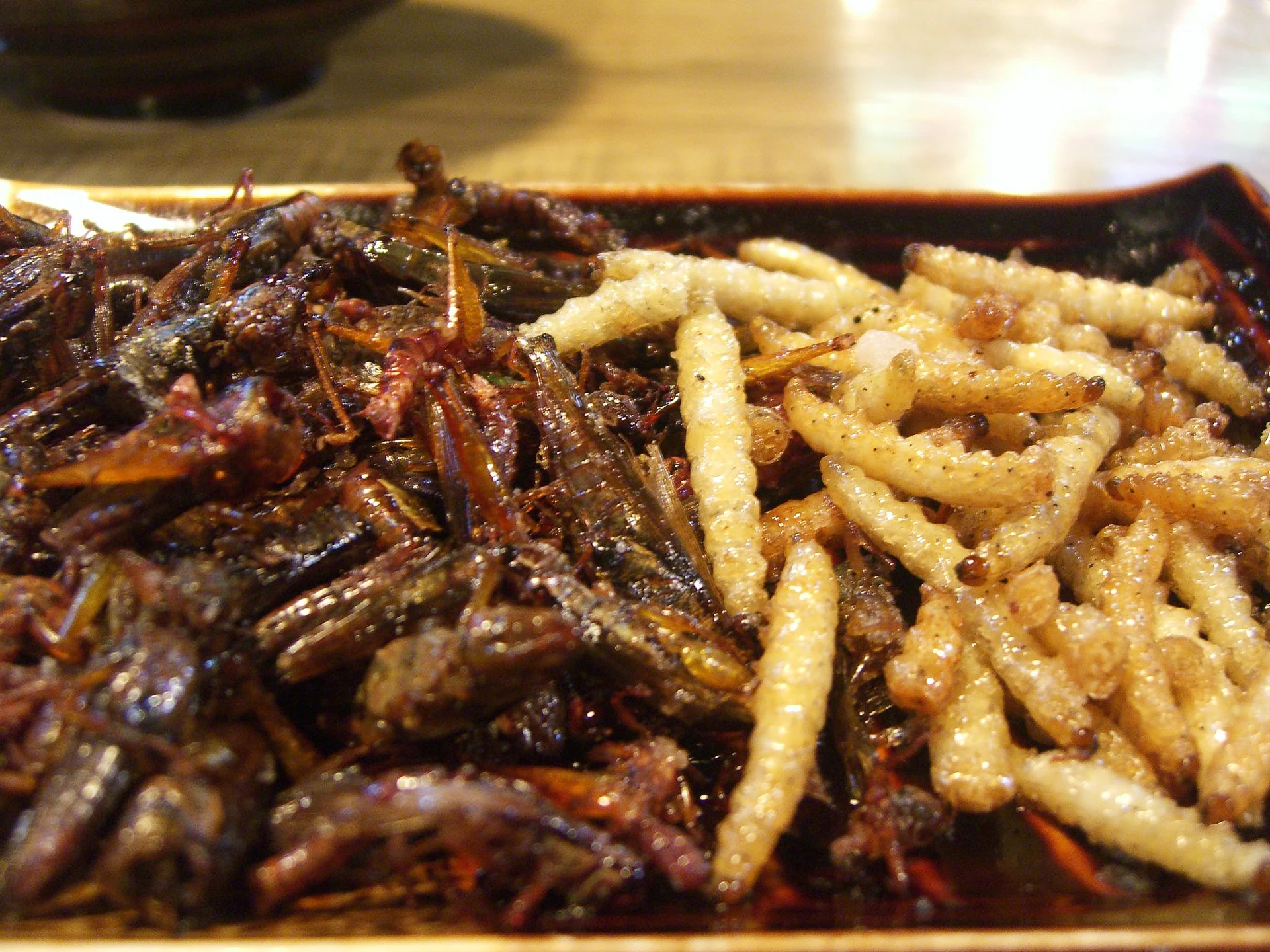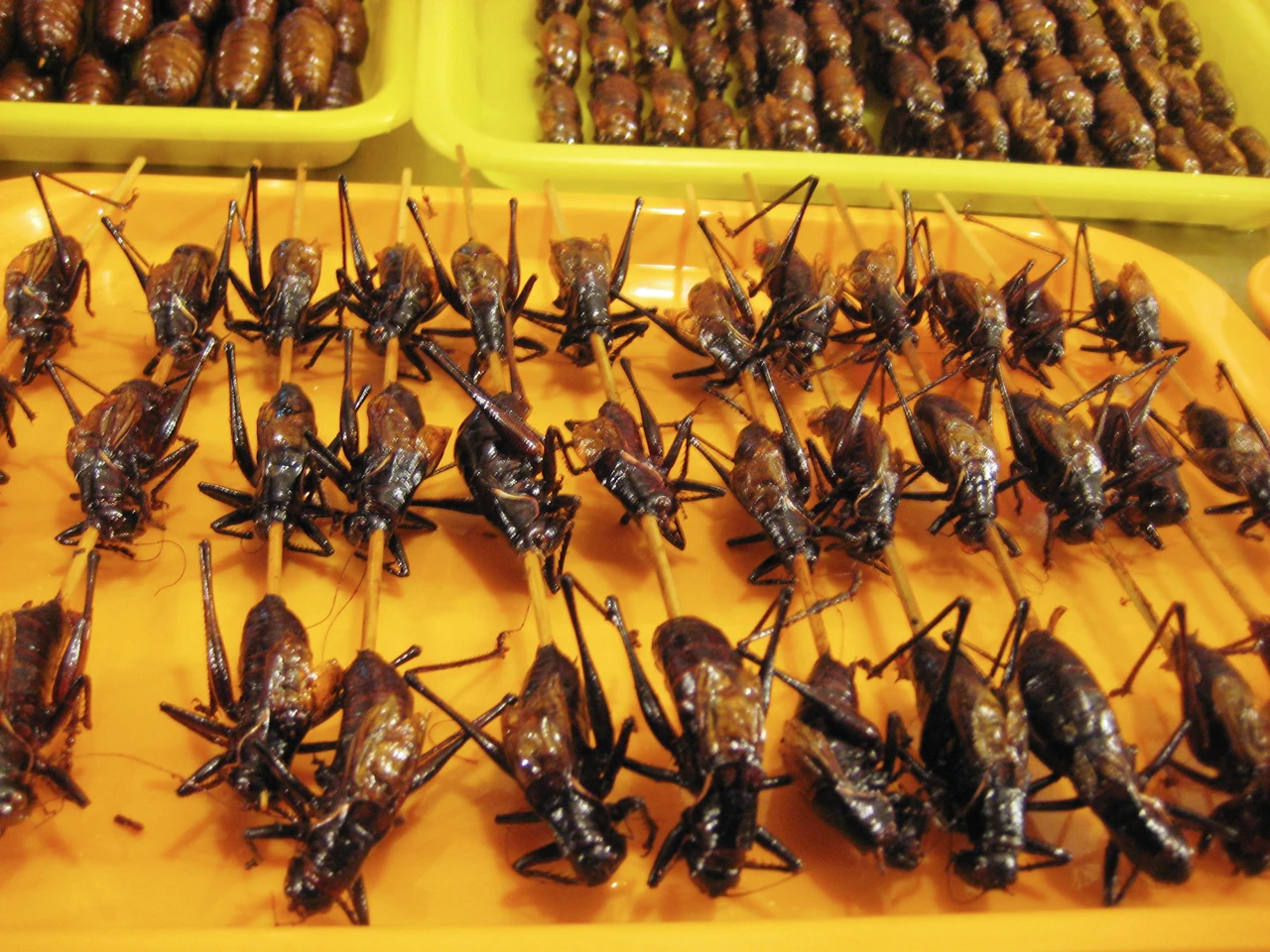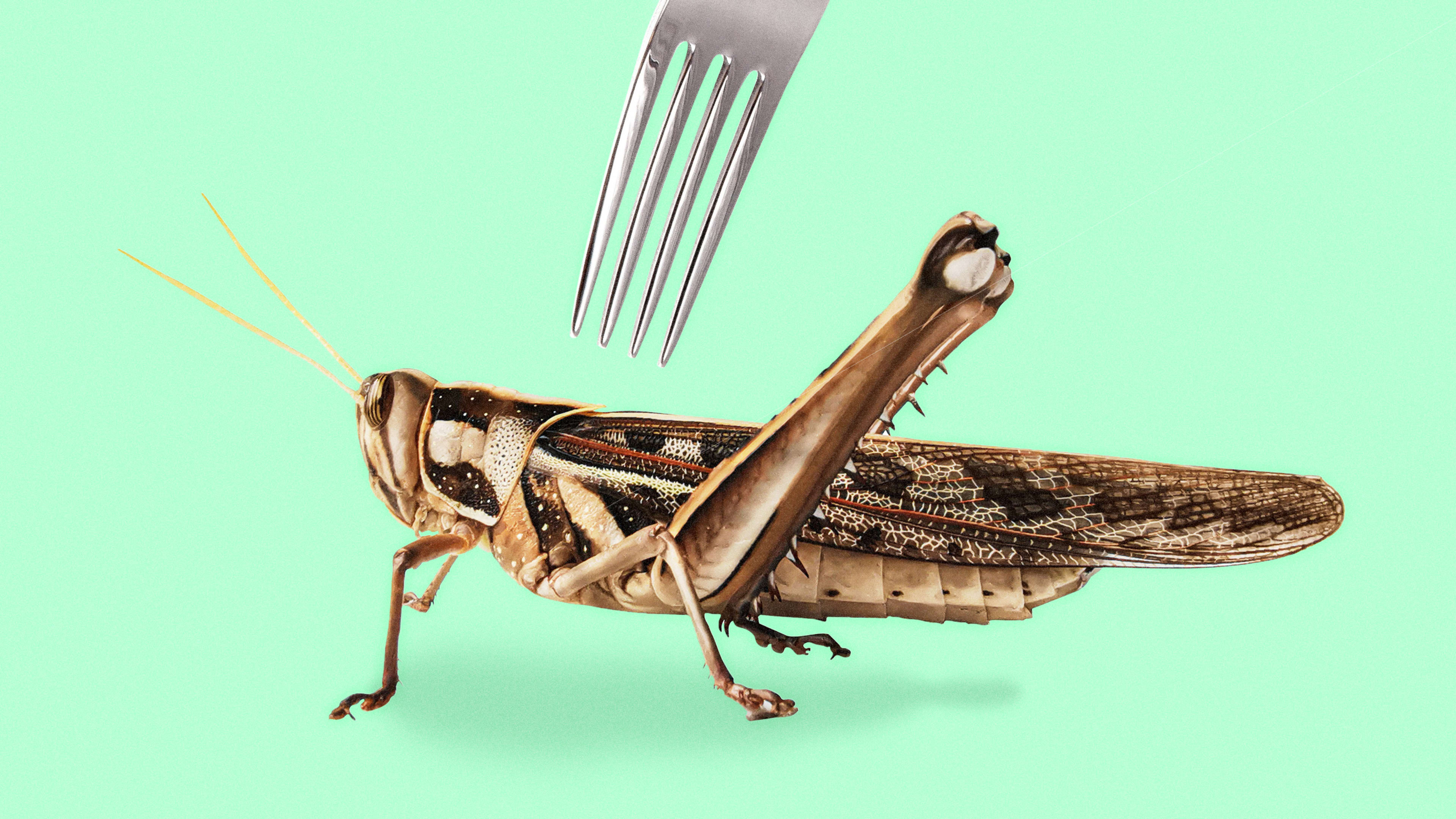In just the past couple of years there has been a hive of activity in the edible insect industry. In the United States, crickets, mealworms, black soldier flies, grasshoppers, ants, silkworms, cicadas, and other crawling critters have found their way into restaurants, baseball stadiums, and even supermarkets in the form of protein bars, pastas, chips, hamburgers, and meatballs. The trend is international: The insect protein market is projected to be worth $8 billion by 2030, up from less than $1 billion in 2019.
For many Westerners, this may come as a surprise. After all, bugs are more likely to appear in our nightmares than on our plates. (Some of the few exceptions include reality television shows of the early 2000s like Fear Factor and Jackass, where only the promise of riches and fame made the stars willing to stomach them.) When people did consume bugs, it was usually by accident, often to the horror of patrons who didn’t order their meal “extra crunchy.”
Despite this culturally ingrained ick-factor in America associated with consuming insects, the reality is that they have long-been a staple in other countries. People in Thailand, for example, commonly snack on a cornucopia of insects that are seasoned and fried in a wok until crispy. And in Mexico, bugs are fried, buttered, or even dipped in chocolate, and mezcal, a Mexican liquor, is often served with a worm. Indeed, there are more than 1,900 known edible insect species on Earth, hundreds of which are already part of traditional diets. The practice of eating insects even has a name: entomophagy.

Advocates of integrating insect consumption into the American diet often argue that eating insects is both good for you and the planet, but some scientists warn that the claims on this topic have been overstated. Most importantly, the case for eating insects is that they could replace other protein sources, meaning an end to factory farms and the horrible life they inflict on livestock. But there is one not-so-tiny moral problem: Insects may experience pain and negative emotional states just as much as a cow or pig.
Historically, the majority of scientists believed that insects likely did not feel pain. (One exception was Charles Darwin, who wrote in his 1872 book The Expression of Emotions in Man and Animals that “[e]ven insects express anger, terror, jealousy and love . . . “) More recently, insects have been discovered to have a certain type of neuron that serves a similar function to nociceptors (pain receptors) in humans, in order to sense dangerous stimuli and thus be able to self-preserve by moving away from those stimuli. However, scientists believed that bugs didn’t have the emotional faculties to code those experience as “pain” and thus, lacked ability to suffer. But the results of more recent studies are ambiguous.
Consider a 2011 study that found that stressed bees are more likely “to see the glass as half empty.” In the initial setup of the experiment, a group of bees was trained to associate two simple odor mixtures with two different foods. One mixture of two chemicals was repeatedly paired with sucrose, which bees find pleasing. The other odor mixture consisted of the same two chemicals in opposite proportions, and was paired with quinine, a compound bees find bitter and will actively avoid after tasting.
After learning these odor-food associations, the bees responded as expected: They uncoiled and extended their mouthparts in anticipation of food when the first odor mixture was presented, and retracted them when presented with the second mixture. Next, half the bees were shaken in a vortex mixer—a device typically used to vigorously mix chemicals, in this case meant to simulate a badger attack on a hive—while the other half of bees served as a control. Next, both shaken and unshaken bees were tested on five mixtures of the two chemicals at different concentrations. Researchers found that the shaken bees were more likely to recoil in the presence of a mixture that had equal amounts of the two chemicals—which meant the bees couldn’t tell if it would be sweet or bitter—while unshaken bees gave the concoction the benefit of the doubt. The physically shaken bees appeared to be emotionally shaken, too. In addition to these behavioral measures, the researchers measured the levels of different neurotransmitters in bee brains, and found ones associated with mood, like dopamine and serotonin, were reduced after being shaken.
A separate 2016 study on bumblebees also demonstrated behaviors that suggest the influence of emotions, displaying what experts call an “optimism bias” in cognitive tests when given a tasty treat beforehand. First, a team of researchers trained bees to distinguish between a blue flower placed on one side of a container and a green one on the other. When the bees encountered the blue flower, they found a reward—a 30% sugar solution. When the bees explored the green flower, they found only plain water. After several trials, the bees learned to associate the blue flower with a sweet snack. (This isn’t that surprising, given that numerous studies show that while bees may have tiny brains, they are intelligent.)
Then, the researchers tested the bees on ambiguously colored flowers, like purple, which were intended to be confusing and mysterious. Half of the bees were given a 60% sugar solution prior to the test, while the other half were given nothing. The bees who received the saccharin snack flew faster toward the ambiguous blue-green flower while the bees who were not given anything flew more slowly. In other words, the treated bees were quicker to “optimistically” fly toward strange new flowers and explore whether some sugary goodness was nearby. Moreover, this optimistic behavior was shown to be interrupted when the bees were given drugs that disrupt the reception of dopamine, a neurotransmitter associated with desire and motivation—this is similar to the effect found in mammals.
This finding implies that having a positive brain state appeared to bias the bees’ decision-making (perhaps similar to how we feel devouring a piece of chocolate cake). “We can’t say they experience life in the same way that we do,” Clint J. Perry, one of the study’s co-authors, told Popular Science. “But on a basic level, there’s no reason to believe they can’t feel something. It does feel like something to be a bee or an ant or what-have-you.”

Yet another study—this time with fruit flies—found “objective evidence that visual stimuli designed to mimic an overhead predator can induce a persistent and scalable internal state of defensive arousal . . . which can influence their subsequent behavior for minutes after the threat has passed,” according to David Anderson, the lead researcher. “For us, that’s a big step beyond just casually intuiting that a fly fleeing a visual threat must be ‘afraid,’ based on our anthropomorphic assumptions. It suggests that the flies’ response to the threat is richer and more complicated than a robotic-like avoidance reflex.”
We’ve already known for some time now that complex social relations exist within insect communities, which complicates the idea that bugs are essentially biological machines that have few of the same mental capacities as larger animals. All in all, evidence suggests that insects are, neurologically, far more than simply a bundle of reflexes built for survival.
Admittedly, emotion is tricky to define, as it’s based on subjective experience. It’s hard to say exactly which observable biological processes consist of subjective experiences significant enough to be morally relevant. But there is evidence to suggest that bees, fruit flies, and some other insects (at least) have the biological constitution to experience emotion. The possibility that they have subjective experiences associated with those biological processes can’t be eliminated based on current evidence. So while there may not be definitive proof that at least some insects can suffer—or experience emotions like joy—there is at least reason to believe that they might.
This conclusion is especially alarming given some realities about the size of edible insects relative to other animals we consume. Because insects are so much smaller than other farmed animals such as cows, chickens, pigs, lambs, and fish, many more individuals must be killed in order to yield the same amount of meat. If we replace our burgers, chicken fingers, turkey bacon, and fish sticks with meat products derived from, say, maggots and locusts, the total amount of animal suffering worldwide—in terms of the number of creatures who live diminished lives, suffer, and die so that we may eat them—might actually go up rather than down. For example, while it requires one cow to produce about 4,500 hamburgers, it requires hundreds (if not thousands) of insects to create a single hamburger. Animal advocate Emilia Cameron puts it like this: “The sheer scale of insects killed, both in the feed production process supplying [factory farms], and in the potential use of them as food for human consumption, means that if they suffer, humans would be collectively responsible for massive . . . levels of suffering orders of magnitude beyond what farmed or human animals experience in their lifetimes.”
However, some skeptics question how much farmed insects would actually suffer: “Even if insects were capable of pain, the conditions that they would be raised in are conditions that would not cause them to suffer. Unlike cattle, pigs, or chickens—and unlike even crabs, lobsters, or shrimp—most insects actually prefer to live in crowded, hot, and filthy conditions,” writes philosopher C.D. Meyers. Robert Nathan Allen, founder of Little Herds, a nonprofit organization that promotes the use of insects for food, argues that farmed insects not only don’t suffer but also enjoy pleasant lives. As he told NPR: “Insects raised in farms live in teeming dark conditions (preferable environment), with ample and abundant food supply, no natural predators, no risk of outside diseases or parasites . . . ”
But as researcher Brian Tomasik notes, “some insect-farming operations have nontrivial mortality rates. And farms occasionally lose almost all their insects to disease.” As one example of many he cites, Big Cricket Farms initially “suffered a setback when a cricket paralysis virus hit the facilities over the winter, killing 90% of the livestock.” Furthermore, even if living conditions were perfect, Tomasik argues that insect farming may still be bad because of the realities of slaughter. Methods vary, but all have the potential to cause suffering. For example, at Big Cricket Farms, this is how farmed insects are harvested, as reported in the New Yorker: “Farm workers carry the mature crickets’ troughs into a walk-in freezer, causing the bugs to go into suspended animation, an evolved response to cold temperatures. Once the bugs are unconscious, the temperature is lowered by another couple of degrees, which kills them.”
While some claim that freezing amounts to “going to sleep” and is completely humane, others are less certain: The BIAZA Recommendations for Ethical Euthanasia of Invertebrates, for example, notes that freezing “[d]oes not provide muscle relaxation or analgesia effects” and is “considered to be inhumane without prior anaesthesia.” And unfortunately, some insects are killed in plausibly much worse ways than freezing. Consider that Kreca, a market leader in the production and delivery of insects for human consumption, first heats human-edible insects at high temperatures, apparently while they are still alive: “When insects are reared for human consumption, more hygienic measures are taken: After sifting they sterilize them in hot water and then they place them in the fridge or freeze-dry them.”
While this is concerning, we may not have to worry in the long-term: Better alternatives are on the rise. Plant-based meats already have a much larger market share of the alternative protein space and are on pace to reach $140 billion within the next 10 years. Cell-based meat—nature-identical meat without slaughter—is also gaining traction. Both alternatives to factory-farmed meat have some of the purported environmental and health upsides of conventionally produced insect-based meats without the potential for suffering. Plus, while the overwhelming majority of Western consumers are still grossed out by the idea of eating insects, plant-based and cell-based meat have robust consumer interest. Such a sentiment may bug advocates of insect-based food tech, but there is still time for them to make a beeline for products from these other industries that wouldn’t hurt a fly.
Brian Kateman is cofounder and president of the Reducetarian Foundation, a nonprofit organization dedicated to reducing consumption of meat, eggs, and dairy to create a healthy, sustainable, and compassionate world. Kateman is the editor of The Reducetarian Cookbook (Hachette Book Group: September 18, 2018) and The Reducetarian Solution (Penguin Random House: April 18, 2017).
Recognize your brand’s excellence by applying to this year’s Brands That Matter Awards before the early-rate deadline, May 3.
